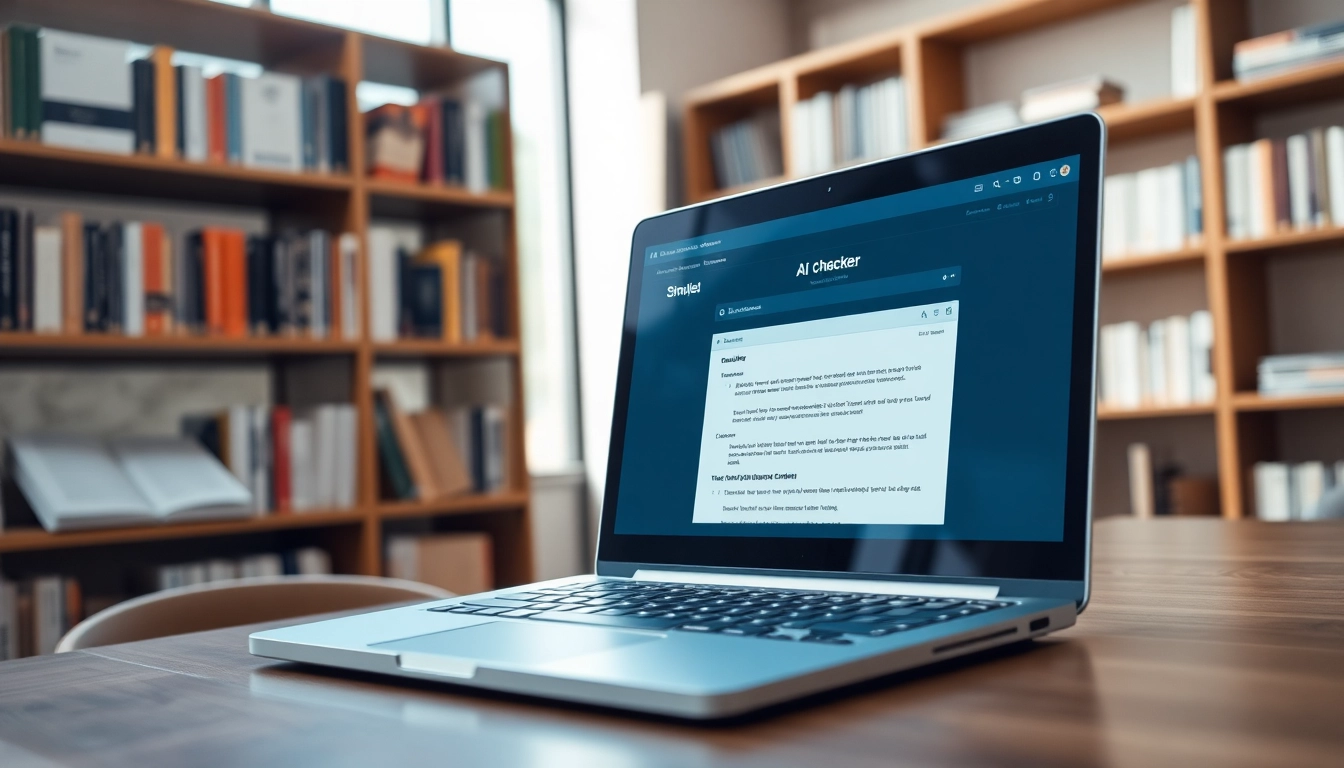What is an AI Checker and How Does it Work?
Definition and Purpose of AI Checkers
An ai checker is a specialized tool designed to analyze text to determine whether it has been generated by an artificial intelligence (AI) model. This technology is particularly crucial for educators, marketers, and content creators who need to verify the authenticity of documents. The main purpose is to ensure integrity in various fields by identifying AI-generated content, which may lack the depth or contextual relevance expected from human writing.
Technology Behind AI Detection
AI detection tools employ complex algorithms and machine learning techniques to analyze patterns of language, style, and structure typical of AI-generated text. Generally, these systems work by training on large datasets of both AI-generated and human-created text, thereby learning how to differentiate between the two based on various linguistic markers. Some technologies deploy Natural Language Processing (NLP) and deep learning to assess the nuances in vocabulary, sentence formation, and coherence.
Common Use Cases for AI Checkers
AI checkers find applications across many sectors, including:
- Academic authenticity: Professors and institutions can check student submissions for originality.
- Content marketing: Marketers ensure that promotional materials are not simply regurgitated AI content but original work.
- Publishing: Authors can confirm that their texts are free from unwanted AI influence before publication.
- SEO optimization: Writers use AI checkers to help ensure content aligns with search engine optimization best practices while remaining unique.
Benefits of Using an AI Checker for Content
Enhancing Credibility in Academic Writing
The integrity of academic work relies on rigorous standards of originality. By employing an AI checker, institutions safeguard academic credibility. Use of these tools can help detect and prevent plagiarism, ensuring students submit their best original work. This is particularly valuable in a landscape where AI-generated content is on the rise, as it allows educators to evaluate the authenticity of papers and presentations more thoroughly.
Protecting Originality in Creative Work
Artists, writers, and creators invest significant time and resources into their original pieces. An AI checker can protect their intellectual property by validating the originality of their work. It assists in identifying portions that may inadvertently mirror AI-generated content, preventing potential disputes over creative ownership.
Facilitating Compliance in Publishing Standards
Publishers and editors are increasingly adopting AI checkers to ensure that submitted manuscripts meet industry standards. This verification process is essential to filter out AI-generated texts that may not match the quality and style expected from authors, preserving the overall credibility of literary contributions.
How to Choose the Right AI Checker Tool
Key Features to Look For
When selecting an AI checker, consider the following features:
- Accuracy: Look for tools that boast high detection rates and are regularly updated with new algorithms.
- User-Friendly Interface: A straightforward design facilitates ease of use, especially for those not technologically inclined.
- Comprehensive Reporting: The best tools provide detailed reports, breaking down areas of concern, types of content detected, and suggestions for improvement.
- Batch Processing: If you often work with large volumes of text, ensure your chosen AI checker can handle bulk submissions efficiently.
Comparing Popular AI Checkers
Some of the leading AI detection technologies include:
- ZeroGPT: Known for its multi-stage methodology and high accuracy.
- QuillBot: Offers a robust set of tools for detecting AI-generated content effectively.
- Grammarly: While primarily a grammar checker, it now includes an AI detection feature.
- GPTZero: Popularized as a reliable means of identifying AI-generated text across various platforms.
Comparing these tools side-by-side can pinpoint the right one for your specific requirements, emphasizing what you value most in detection capability.
User Experience and Support Considerations
Last but not least, consider the support infrastructure surrounding AI checkers. Is there customer service available? Are there tutorials or help sections dedicated to troubleshooting common issues? The responsiveness and ease of access to customer support can significantly enhance your experience with the chosen tool.
Best Practices for Effectively Using AI Checkers
Interpreting Results and Recommendations
It’s not enough to simply run your text through an AI checker. Understanding the results is crucial. Many tools categorize flagged content into different levels of concern—low, medium, and high. It is essential to analyze the reasons behind a flag to refine writing and approach, ensuring genuine originality and quality. Use the feedback as a guide to improve future writing.
Combining AI Checkers with Other Tools
AI checkers are most effective when used in conjunction with other writing tools. Pair them with grammar checkers, plagiarism detectors, and style guides to cultivate a comprehensive approach to content creation. Each tool checks for different factors, meaning a combination can lead to more polished and professional material.
Staying Updated on AI Detection Technology
The fast evolution of AI means that detection technologies are also continually upgrading. Staying informed about the latest trends, updates, and research in AI detection technology is crucial. Regular training, subscribing to pertinent newsletters, and engaging with communities in content writing can empower you to leverage the tools best.
Future Trends in AI Checking Technologies
Advancements in Detection Algorithms
As machine learning progresses, the ability of AI detectors to analyze text will enhance. Newer algorithms are likely to consider even subtler patterns in language use, including emotional tones and nuances in dialect, allowing a more comprehensive understanding of whether content is AI-generated or not.
Integration with Other Digital Tools
Integration is another emerging trend. AI checkers will increasingly integrate with content management systems (CMS) and writing software for seamless operations. This interoperability can streamline the writing process, allowing writers to receive real-time feedback without switching between platforms.
Ethical Considerations and Transparency in AI
As the need for AI detection grows, so do the discussions surrounding ethical practices. Transparency regarding how AI detectors work and what data they use will become increasingly vital to user trust. Expect more rigorous ethical standards to emerge, focusing on the responsible use of AI detection tools in order to minimize bias and errors.















Leave a Reply